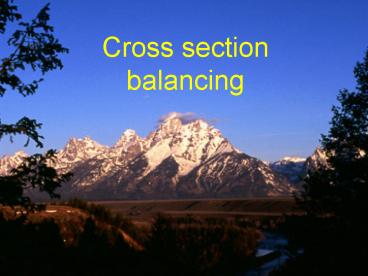Cross section balancing PowerPoint PPT Presentation
1 / 14
Title: Cross section balancing
1
Cross section balancing
2
Deformed-state cross sections
- Deformed-state cross sections can be constructed
using map data, well data, and, if you're lucky,
seismic data.
Deformed-state section from Glacier National Park
3
Deformed-state cross sections
- All cross sections involve interpretation. They
are not data. - Admissible cross sections Interpretation matches
surface and subsurface data fault and fold
geometries match expected for thin-skinned
fold-and-thrust belts
Interpretation
4
Some criteria for admissible sections
- Ramps do not dip steeper than 35
- Flats follow weak layers
- Fault geometries match the geometries of
overlying folds - Out-of-sequence faults are justified
- Hinter-land-dipping faults are justified
See McClay, 1991, Glossary of thrust terms
5
Not admissible Does not match expected thrust
geometries
Admissible Matches expected thrust geometries
6
Restored cross sections
- Restored section can be constructed that depicts
the probable pre-deformation geometry of the
deformed beds
7
Restored cross sections
- Individual thrust sheets are "pulled back" to
their pre-thrust positions by matching footwall
and hanging-wall cutoffs at ramps.
HW cutoff
FW cutoff
8
Viable cross section Deformed-state section that
can be restored such that bed length and/or bed
area is conserved and fault geometries are
admissible
9
Balanced cross section Deformed-state section
that is both admissible and viable.
Do you think this is a balanced cross section?
Why?
10
Restoring a cross section
- Pick regional pin linePoint in deformed-state
section that is not allowed to move - Set up stratigraphic reference frame for restored
section. Account for changes in bed thickness
(most platform sedimentary packages thicken
towards hinterland)
11
Restoring a cross section
- Work in order from youngest faults to oldest.
- Add local pin lines in thrust sheets as needed.
12
Restoring a cross section
- Keep track of the loose line on the hinterland
end of the section.
Acceptable loose lines must be straight or form
smooth curves. a, b, and c are acceptable. d and
e are not.
13
Restoring a cross section
- Keep track of the loose line on the hinterland
end of the section.
Unacceptable loose line, must modify section to
balance
14
Modified deformed-state section and new restored
section Section is now balanced
Previous section

